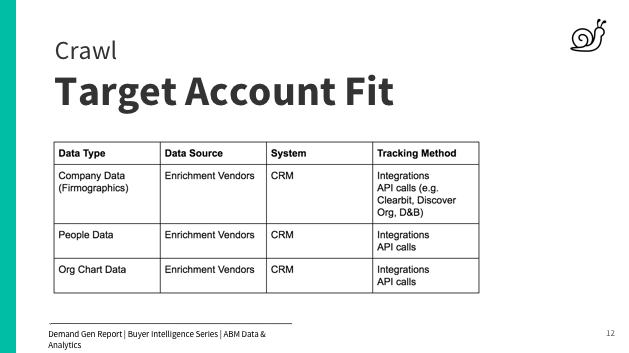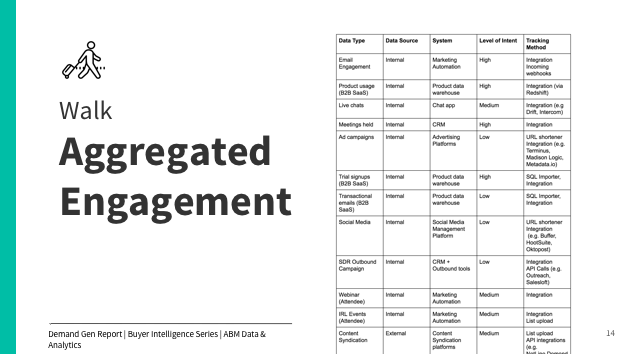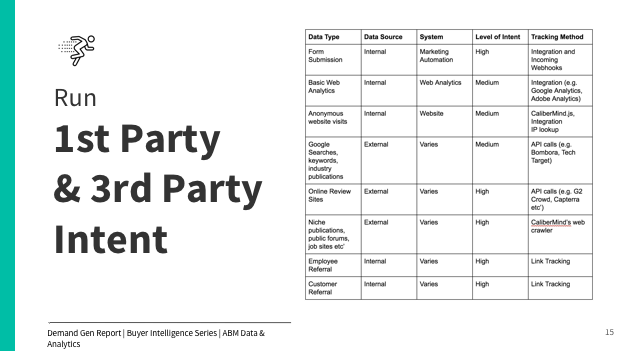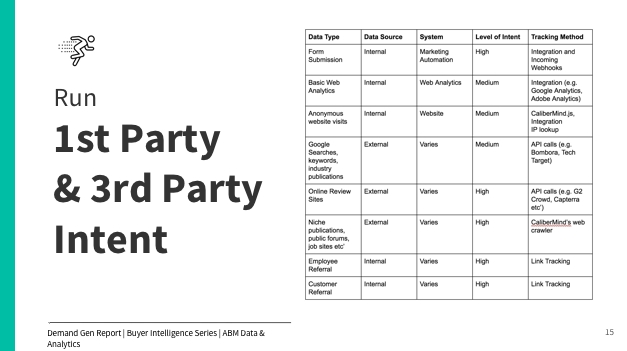Most marketers don’t automatically think of data and analytics when it comes to ABM. However, industry experts agree that ABM is a data and analytics challenge because you have to leverage data and analytics to understand who you’re going to target, what you’re going to say to them and how you’re going to drive action throughout the company based on the accounts that matter most to you.
During a webcast, part of Demand Gen Report’s Buyer Insights & Intelligence Series, former Dun & Bradstreet CMO Rishi Dave urged viewers to look at ABM in three fundamental parts:
1. As you think about who you want to target, an integrated data set is crucial for a full view of your customers.
“Step-one is bringing all of your data together in that integrated data set,” he said. “Because you’re marrying your own data with third-party data, you have a unique data set that nobody has — including your competitors. By leveraging that data set, you have a differential way to retarget the right set of accounts for your products and services.”
2. Build analytics on top of the data set, including propensity modeling.
“When you have the integrated set, it doesn’t mean anything unless you have insights from that data,” said Dave. “You need analytics. For example, propensity modeling to understand what accounts provide the biggest opportunities for different lines of businesses served. We also invested in lookalike modeling.”
3. Take real-time action on your data and insights.
“Most importantly, once you have a base level set that’s updating in real time and you have the analytics that give you the insights on what you should do, now it’s time to take real-time action on that data and on those insights,” said Dave. “That’s perhaps the part that people forget the most: once you have those insights form the analytics how do you surface them in a way that you can take action on them in real time as opportunities change. How do you surface those insights both to the humans that interact with your customers as well as to the systems that drive automated interactions with your customers?”
Understand Your Customer With A Crawl, Walk, Run Approach
During the webcast, Dave was joined by Chris Nixon, VP of Marketing at CaliberMind, and Kayla Kirkeby, VP of Marketing for Dizzion, to spotlight a three-step approach to understanding your customers: Crawl, Walk, Run.
CRAWL

Crawl is designed to help you understand fit.
“When we think about fit, it’s about taking the data that you have on target accounts and companies (things like firmographic data — size, revenue, industry, technology they use and location) and bringing it all together in a single source,” said Nixon. “Once you have that, make sure you have the data on the people. Who are the personas of the people at those target accounts you want to engage with?”
At Dizzion, Kirkeby said that to create their ideal customer profile (ICP), the team sat in a room and took a hard look at their most successful customers. “Lookalike modeling is great example and important piece to ABM, but you can’t do that until you know what a successful customer looks like,” said Kirkeby.
The company looked at five to 10 customers that they wanted to have more of. “We looked at different things within sales and marketing processes and where those deals came from,” said Kirkeby. “Was there a frictionless sales process and deployment after sale? Who did we sell through? What were the target personas and consistent themes of firmographic data?”
WALK

Once you’ve mastered fit, move to walk — or aggregated engagement.
“What’s important here is a lot of [marketers] are doing lead scoring at a contact level,” said Nixon. “To start walking, the lead score is important but only provides little insight to one person. Target accounts have a buying committee, so there are multiple people involved. To elevate, aggregate that and build it into an engagement score at the account level.”
Kirby agreed that the main point to take home is the aggregation of data at the account level. “If someone is trying to sell to me and my team, and I’ve got one person showing engagement by attending webinar or doing research, that’s a single person in the buying committee,” she said. “Who’s to say that one individual has any authority or influence over the buying decision? Maybe they’re just doing research. That is quite different than an organization wanting to seriously evaluate potential technology solutions. The aggregation of those actions of an individual up to the account is really critical.”
RUN

Once you have a firm grasp on fit and engagement, you can move to first- and third-party intent.
An example for first-party intent data is anonymous visitors to your website. “You can take anonymous visitors and reveal that through technology,” said Nixon. “Then you can attach personas to that account, ensure it’s a target account for you and run some programs against it.”
An example of third-party intent data is online reviews on sites such as G2 Crowd. “[These companies] are capturing the people that are going to the marketer/segment you’re classified in and are able to capture that information and itemize the people that are [researching]. So, what the intent signal is telling you is there’s someone in market looking for a solution like yours because they’re looking at this category of solutions that you exist in.”
Dave emphasized that it’s also key to look at where these signals are coming from, not just who’s coming to the site. “When you’re selling to a big global company, it’s made up of a lot of divisions and locations and there are different buying groups in those locations,” he said. “What we’ve frequently done with our enterprise sales team is look at not just when signals are coming in but also what location or division they are coming from. With third-party data, you can understand the hierarchy of these accounts, such as corporate, different divisions and locations.”
The insights don’t stop there. Check out the webcast — titled: How To Harness Data & Analytics To Execute And Report On Account Intelligence — on demand to learn more about how to optimize ABM performance and measure impact, as well as how to repurpose your tech stack to be able to track and measure your campaigns and more.







